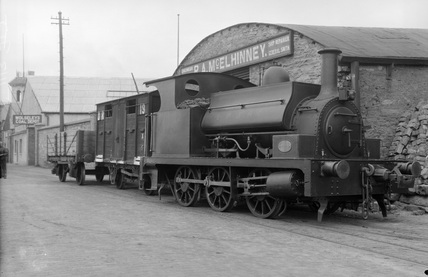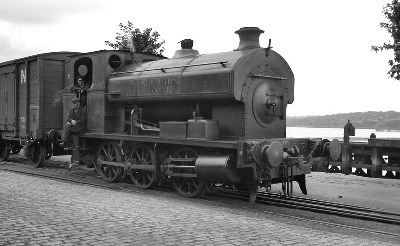-
Posts
547 -
Joined
-
Last visited
-
Days Won
1
Content Type
Profiles
Forums
Events
Gallery
Everything posted by Dhu Varren
-
Unfortunately, that link is not for a split chassis locomotive. This one is, http://www.rmweb.co.uk/community/index.php?/topic/95131-dcc-fitting-a-bachmann-lord-nelson-with-split-chassis/.
-
I converted two Bachmann split chassis locomotives to DCC yesterday. It is not overly difficult to do so, but entails stripping the chassis down to component parts in order to isolate the motor. The conversion is easy enough, but not for the faint hearted.
-
-
A bit of research has revealed that the LPHC appears to have had a number of locomotives over the years. The first No 1 was ex L&LSR No 3 by Robert Stevenson, purchased by LPHC in 1869. Scrapped in 1888. The first No 2 was ex L&LSR No 2, previously No 4, by Robert Stevenson, purchased by LPHC in 1882. Scrapped in 1891. The above locos were 5’ 3” gauge, and were the same. A picture of one of them, while with the L&LSR, is opposite P17 of E M Patterson’s ‘The Lough Swilly Railway’. The second No 1 was by Robert Stevenson, purchased in 1891, preserved in UFTM. The second No 2 was by Robert Stevenson, purchased in 1896, scrapped in 1928. These two locos were also the same. No 3 was by Avonside Engine Company, purchased in 1928, preserved by RPSI.
-
[quote=Horsetan;81631 A bit close to the idlers. Close does not matter, only a problem if they touch. In any case, it would be easy enough to move the two idlers up a bit to allow a bit of vertical movement of the axle.
-
The original bridge had had double track, but was worked as a single line to avoid having two trains on the bridge at the same time. When the bridge was replaced in the early 1930s, the line was temporarily singled for the duration of the work, and the new bridge was built inside the old one. This then meant that the new bridge was too narrow for double track, but since there had a restriction on having two trains on the bridge at the same time for many years, the provision of gauntleted double track was not a problem. On completion of the new bridge, the old bridge was then dismantled.
-
I did a double take when I read it, but the text refers to No2, an 0-6-0 saddle tank of 1928, R.H.Smith. The spelling of Smith is as written. Unfortunately, not the only errors regarding the LPHC. It also states that the only connection the GNR had was via a connection into a platform in the GNR station, but there was, in fact, a direct connection, passing under the Craigavon bridge. It is possible, of course, that the direct line would not have been suitable for locomotives, as it would involve crossing the wagon turntable under the bridge.
-
There is a reference to a No2 in 'Saga By Rail' on P56 & P57, but it is an error, as the loco referred to as No2 is, in fact, No3.
-
[ATTACH=CONFIG]21762[/ATTACH] I would have to agree that the scale of the Oxford truck is a bit suspect. The box trailer of the Tesco truck measures 156mm, which equates to 39ft in OO. This would make the Tesco truck just a tad under 1/76 scale. In HO a 40ft container would measure 140mm. In comparison, the Oxford 40ft container in the picture is significantly longer than the Tesco trailer, which would make it a much larger scale. My calculations work it out to be about 43ft in OO, making it a good bit larger than 1/76 scale.
-
Whilst studying Mayner's and Maitland's excellent photos of mixed gauge track, it came to me that while TT/HOm track is perfect for 3ft gauge track, when used in conjunction with OO gauge track to form mixed 3ft and 5ft 3in gauge track, the proportions are totally wrong. N gauge track is almost perfect for 3ft/5ft 3in mixed gauge track when using OO gauge track. 12mm (3ft) track with 21mm (5ft 3in) track gives a ratio of 1 - 1.75. 9mm track with 16.5mm track gives a ratio of 1 - 1.8. 12mm track with 16.5mm track gives a ratio of 1 - 1.375.
-
I have never come across a No2, but I am sure there must have been one. I only ever saw No1 in the flesh languishing in the loco shed, but never working. Latterly No3 was only used in the winter, when there was ice & snow, Fordson Major tractors were used most of the time. I was lucky enough to get a cab ride on No3 in the early 60s.
-
It is more likely that the fertiliser traffic would have only gone as far as Strabane, as that was the railhead for Donegal. Derry Waterside only became the railhead after the Derry Road had closed.
-
Below is a picture of Derry docks with an arrow showing where I believe the original picture was taken. http://www.britainfromabove.org.uk/image/XAW027080 Here are also two pictures of the LPHC locos, No1 in what has to be a posed shot with both broad gauge and narrow gauge wagons behind it, at the entrance to the loco shed. Also No3 taken towards the L&LSR Graving Dock Station further along the quay. Note the offset NG coupling on the buffer beams. Note the rope wound round the buffers of No3, used for dragging wagons into parallel tracks.
-
Judging by how narrow it is at this point (no pun intended), I would suggest that the picture was taken in the vicinity of the Burns Laird Line shed which would be on the right behind the wagons. This would now be in the vicinity where the current bus station is. At the top centre of the picture is open quayside, probably near the Guildhall, where there were steam cranes for unloading the likes of coal. The presence of open wagons would also suggest that. I have no idea why the track on the left is like that, unless it curved off into a building on the left.
-
Before you fit any decoder to your locos, ensure that they are running 100% perfectly on DC. Fitting a decoder to a loco that is not running perfectly will only make it run worse. Like Noel, and others have said, stay away from the Hornby DCC controllers, particularly the Select, as once you have got past the initial starting phase with DCC, you will wish you had gone for something less basic. Yes the Select will work with other decoders, but it is very limited in what it will do, apart from make the loco move.
-
I would agree with Warbonnet about the early Bachmann 20 sound. At speed, it always reminded me of a demented lawnmower. I cannot comment on their latest version as I have not heard it, but certainly, the Howes version is much better, as is Legomanbiffo's sound. The latest Bachmann 20 sound has probably been rehashed to work on the latest, much better, Loksound V4 decoder. As for horns, if you speak nicely to whoever is reblowing a decoder for you, they can quite easily change the horn sound for you, if you can provide a sound recording for them, or can suggest a suitable alternative from their existing BR loco range.
-
-
OO-9 track is only 9mm gauge. In OO, 3ft gauge track is 12mm gauge. The options would be TT track which is spot on at 12mm, or HO-m which, although it translates to 13mm, is actually 12mm gauge, and is available from Peco.
-
According to Colm Flanagan's book, all six of the 'Bullieds', 2660-2665, were rebuilt as powered intermediates. The two in the picture are conversions, the nearest one being 2662, one of the original 'Bullieds'. However, the other vehicle, on closer examination, is slightly different in construction, and is probably one of the earlier AECs, three of which were converted to powered intermediates after repair from accident damage, 2666-2668.
-
There are drawings of the AECs and BUT 700s in Colm Flanagan's book 'Diesel Dawn'. I have drawings of both the BUT 700s and 900s, but not the AECs, which I obtained from the UFTM at Cultra many years ago.
-
That would make sense, as I have been unable to find any pictures or video of exhausts or exhaust smoke above roof level. There is a good clear picture of the rear end of a railcar on P19 of Norman Johnston's book, 'The GNR(I) in Colour', and there is no trace of an exhaust pipe. The only exception I came across was a picture posted earlier, where there is an exhaust on the front end. http://catalogue.nli.ie/Record/vtls000306151 On the other hand, the BUTs seem to have had the exhaust on the end, certainly there are a number of pictures showing an exhaust on the end, but only one end.
-
A good picture of the business end of Railcar A. No sign of any lifting gear fitted to it though, although in the picture posted by garfieldsghost the wagon behind has some form of gantry fitted. http://catalogue.nli.ie/Record/vtls000306976
-
More fool the people buying them.
-
Yes it is correct. Railcar A suffered damage during shunting in 1963 at one end, and was sold to a contractor who removed the bodywork from the damaged end, fitted lifting gear and winches and used it for dismantling the Clonsilla Jct to Navan line. It was also used by the same contractor to dismantle 'The Derry Road' in 1966.
.png.c363cdf5c3fb7955cd92a55eb6dbbae0.png)







